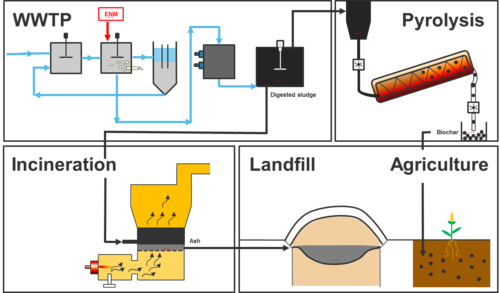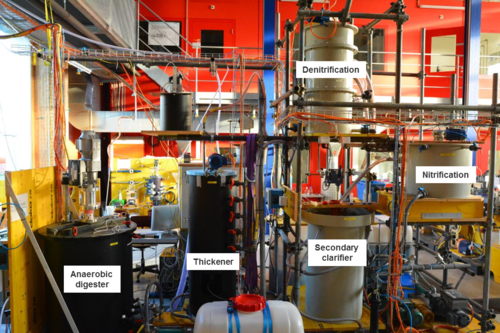WP5
ENM transformation in and release from managed waste streams
Lead: Ralf Kaegi, EAWAG Aquatic Research
Managed waste facilities – so-called "reactors" – act as crucial conduits for engineered nanomaterials (ENMs) prior to their release into the environment. Key reactors include wastewater treatment plants (WWTPs), solid waste and dedicated sewage sludge incinerators as well as landfills (Figure 1). Within each of these reactors, ENMs can be physically and chemically transformed, and their initial coating may be replaced by other (naturally occurring) substances or be biologically degraded. The physical-chemical properties of the transformed ENMs are however are still very poorly investigated. Thus, the general aim of this work package is to establish transformation and release rates of ENM during their passage through different reactors. Additionally, selected lab-scale experiments are conducted using pristine and well-characterized materials to obtain a mechanistic understanding of the transformation processes during different waste treatment processes. Experimental results feed directly into the development of a mathematical model describing the transformation and transfer of ENMs through the investigated reactors.

Main waste management stages investigated in WP5. ENM enriched digested sludge obtained from the WWTP experiment is subjected to pyrolysis and incineration processes, resulting in chars and ashes. The behavior of residual ENM in ashes is further evaluated in simulated landfill experiments. As ENM containing biochars may be applied in agriculture to enhance soil properties, their behavior is assessed in a lysimeter experiment.
Scheme depicting the main waste management stages, investigated in WP5. ENM enriched digested sludge obtained from the WWTP experiment will be subjected to pyrolysis and incineration processes, resulting in chars and ashes. The behavior of residual ENM in ashes will then be further evaluated in simulated landfill experiments. As ENM containing biochars may be applied in agriculture to enhance soil properties, their behavior will be assessed in a lysimeter experiment.

The pilot scale WWTP at the EAWAG facilities in Switzerland. The plant is operated with real wastewater, directly fed in via the local public sewage network and an upstream primary sewage treatment.
An increasing share of sewage sludge is combusted in mono-combustion facilities (typically fluidized bed reactors, Figure 1), allowing recovery of phosphorous from the fly ashes. As an alternative thermal treatment pyrolysis has emerged, which offers many advantages over the combustion process (e.g., energy, reuse of the material). In addition, the biochar resulting from the pyrolysis is used in agriculture to enhance soil properties (Figure 1).
Therefore, in the sequenced stages of WP5, ENM enriched sewage sludge from the first stage experiment and selected case study materials is incinerated and different fractions of the incinerated materials characterized to evaluate potential ENM transformations. The generated ashes are then used for elution and column experiments to quantify the release of ENM from the respective materials deposited in landfills (Figure 1).
Biochar is also generated from ENM enriched sewage sludge using a pilot scale pyrolysis reactor. Finally, the quality of the biochar and its ENM release potential is evaluated based on standardized elution and simple lysimeter experiments.
